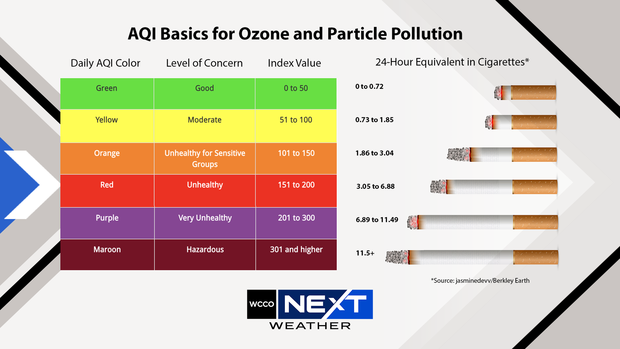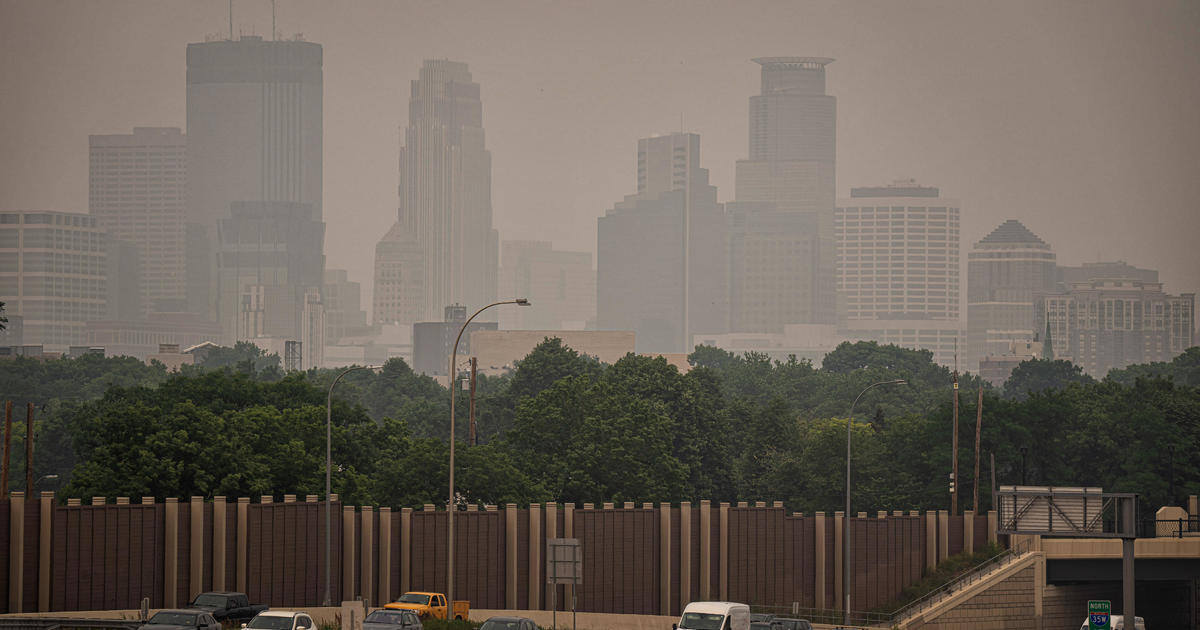Minneapolis' worst air quality day was equivalent to smoking half pack of cigarettes
MINNEAPOLIS – Minnesota's never-ending winter made a quick change into an unprecedented season of never-ending air quality alerts.
Since mid-May, the Minnesota Pollution Control Agency (MPCA) has issued 19 air quality alerts across the state. That's the second most ever issued by the agency. Minnesota is also on its seventh ozone alert of the season -- the most alerts of its kind ever in the state.
Most alerts issued so far this year have been in the "orange" zone, which means the air quality index (AQI) is between 101-150. That air poses a hazard to sensitive groups like seniors, children and teens, and people with breathing conditions.
RELATED: What to do during an air quality alert: Expert advice on how to protect yourself from wildfire smoke
But on June 14 of this year, the AQI reading in Minneapolis was 243, placing it in the "purple" zone, which is the second-highest tier. That reading was the highest ever recorded by the MPCA since they started keeping track of daily stats in 1980.
Anyone who spent any time outside that day could tell just how nasty the air was, but here's a bit of perspective to wrap your respiratory system around.
A user of the open-source software development website Github created a calculator that converts a given AQI value into cigarettes. On a normal day, the AQI level is between 0-50. On the high end of that range, breathing in that air in a 24-hour period is about equivalent to smoking 0.72 of an entire cigarette.
How about on that unprecedented day of hazardous air in Minneapolis? The AQI value of 243 means folks who spent most of their time outside on June 14 were breathing in particulate-rich air that was roughly equivalent to smoking 8.8 cigarettes.
The calculator, made by Github user "jasminedevv," based its math on the work of researchers Richard A. Muller and Elizabeth A. Muller, which was first published by Berkeley Earth in 2015. The researchers created their own calculation by looking at the number of cigarettes sold annually in the U.S., the number of people who died annually from smoking in the U.S., and the number of people who died annually in China from hazardous air exposure.
RELATED: Air quality alert issued in Minnesota due to "ground-level ozone": What does it mean?
According to their research, the worst daily AQI level ever recorded in the industrial Chinese city of Shenyang was nearly 1,300 – five times worse than Minneapolis' worst day. That's the equivalent to smoking 63 cigarettes in a 24-hour period.
WCCO News spoke Tuesday with MPCA Supervisory Meteorologist Matt Taraldsen about Minnesota's unusual stretch of bad air.
"Last year the meteorology did not favor any smoke intrusions. There were still fires in Canada, but we didn't have any air quality alerts last year," Taraldsen said.
He says another factor at play is the increase in cars on the road churning out more ozone-producing pollutants. More commonly called smog, summer winds out of the south also bring ozone pollution from the Chicago area into Minnesota. That's combining with what's left of Canadian wildfire smoke in the area.
"We call them volatile organic compounds (VOCs). The pollution from car exhaust, factories, things like that have more or less returned to how they were before the pandemic," he said.
The long, dry days with little wind and warmer-than-average temperatures and low humidity put those VOCs to work.
"A lot of very comfortable days. It hasn't been too kind of sweaty and nasty out there. That is actually a really good environment for ozone formation," he said.
What about the hazy skies we've recently experienced in the morning? That's the smoke. It's just not in a high enough concentration to impact health.
RELATED: How can wildfire smoke travel so far?
"The volatile organic compounds are also found in smoke. And so it's basically starting off the day already at a higher level and then as the day goes on as the sun bakes that smoke, it converts it from the volatile organic compound state into ozone," he said.
The MPCA says Minnesotans can expect several more air quality alerts this summer. The best way to protect yourself if you have to venture out on those days with pervasive wildfire smoke is to wear an N95 mask.
However, those masks provide little protection against ozone because the molecules are too small. The MPCA recommends people limit their time outdoors, especially those with health issues.
On high ozone days, you can reduce pollution by combining errands and reducing trips. Avoid idling in your vehicle, and gas up at night when it's cooler.




